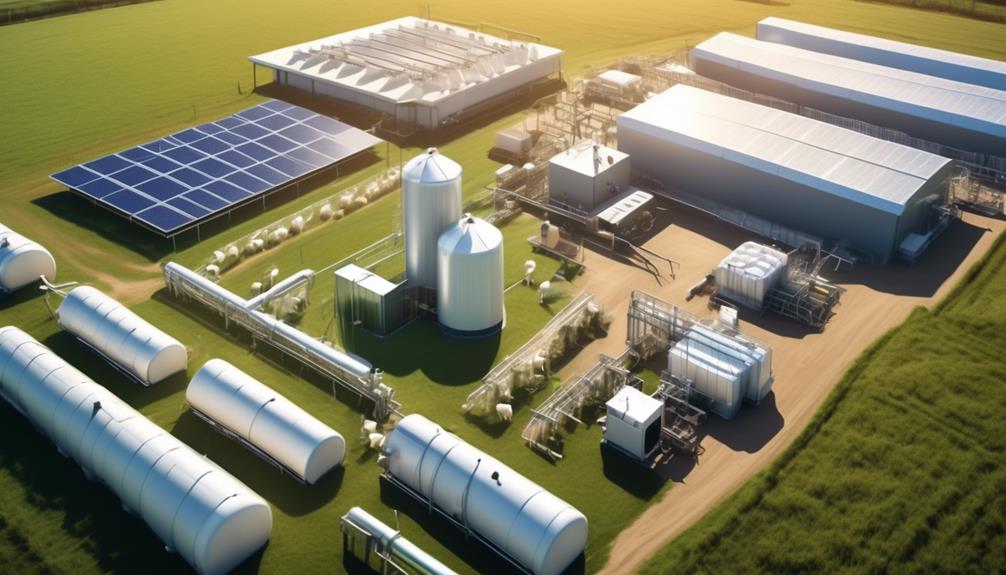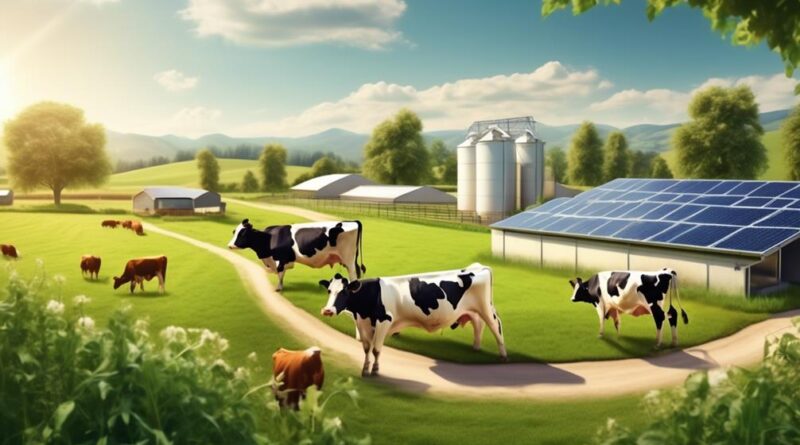Why Is Dairy Production's Environmental Impact Being Reduced?
Have you ever wondered why dairy production's environmental impact is being reduced?
The dairy industry has been making significant strides in minimizing its environmental footprint, and there are several key factors driving this positive change.
From innovations in cattle feed to the integration of renewable energy and the adoption of low-emission farming practices, the industry is undergoing a transformation to become more sustainable.
But what exactly are these advancements, and how are they contributing to a greener future for dairy production?
Advancements in Cattle Feed
In the quest to reduce the environmental impact of dairy production, advancements in cattle feed have been pivotal in improving the efficiency and sustainability of dairy farming practices.
Nutritional supplementation plays a crucial role in ensuring that dairy cattle receive a balanced diet, which not only enhances their health and productivity but also reduces the environmental footprint of dairy farming.
By providing cattle with precise nutritional supplements, farmers can optimize feed utilization, minimize waste, and decrease the overall environmental impact of dairy production.
Grazing management is another key aspect of advancing cattle feed. By implementing strategic grazing practices, farmers can ensure that cattle have access to high-quality forage, which reduces the need for supplemental feed and minimizes the environmental resources required for feed production.
Effective grazing management not only benefits the nutritional intake of cattle but also promotes sustainable land use, reduces greenhouse gas emissions, and protects natural habitats.
Additionally, rotational grazing systems can help improve soil health, water retention, and biodiversity on dairy farms, further contributing to the environmental sustainability of cattle feed practices.
Sustainable Manure Management
Implementing sustainable manure management practices is crucial for minimizing the environmental impact of dairy production while maximizing resource utilization. Manure composting is a key component of sustainable manure management. It involves the decomposition of manure through microbial activity, resulting in a nutrient-rich soil amendment that can be used to improve soil quality and fertility. By composting manure, dairy farms can reduce greenhouse gas emissions, improve nutrient management, and decrease the risk of water and air pollution. This process not only mitigates the environmental impact of manure but also provides an opportunity for farms to create value from waste.
Another important aspect of sustainable manure management is biogas production. Biogas is a renewable energy source produced through the anaerobic digestion of manure. This process not only helps to manage manure but also generates biogas that can be used for heating, electricity, or fuel. By capturing biogas, dairy farms can reduce their reliance on non-renewable energy sources and lower their greenhouse gas emissions. This closed-loop system not only addresses the challenge of managing manure but also contributes to the sustainability of dairy production.
Efficient Water Usage
Maximizing water efficiency is crucial in minimizing the environmental impact of dairy production while optimizing resource utilization. Efficient water usage in dairy production involves implementing water recycling and precision irrigation techniques.
Water recycling systems capture and treat wastewater, allowing it to be reused for various purposes within the dairy operation. By recycling water, the demand for fresh water is reduced, lessening the strain on local water sources. This not only conserves water but also minimizes the potential for water pollution.
Precision irrigation, another key aspect of efficient water usage, involves delivering water precisely to the plants or crops, minimizing waste and optimizing water utilization. This technique ensures that only the necessary amount of water is provided, preventing over-irrigation and runoff. By implementing precision irrigation systems, dairy farms can effectively manage water resources while promoting sustainable agricultural practices.
In addition to water recycling and precision irrigation, the strategic placement of water storage facilities and the use of water-efficient equipment further contribute to efficient water usage in dairy production. These measures not only reduce the environmental impact but also lead to cost savings for dairy farmers.
As the dairy industry continues to prioritize sustainable practices, efficient water usage plays a pivotal role in achieving environmental stewardship while maintaining productivity.
Renewable Energy Integration
To further enhance the sustainability of dairy production, consider integrating renewable energy sources to minimize environmental impact and optimize resource utilization. Incorporating solar power integration and wind energy utilization can significantly reduce reliance on non-renewable energy sources. Solar panels can be installed on rooftops or open land within dairy farms to harness the abundant sunlight, while wind turbines can be strategically placed to capitalize on the wind resources in the area. This integration not only reduces the carbon footprint but also cuts down long-term energy costs for dairy operations.
In addition to solar and wind energy, biomass energy generation can be utilized by converting organic waste such as manure and crop residues into biogas through anaerobic digestion. This process not only produces renewable energy but also helps in managing waste effectively.
Furthermore, geothermal energy implementation can be explored in regions with suitable geological conditions. Geothermal heat pumps can provide heating, cooling, and hot water, reducing the reliance on traditional energy sources.
Low-Emission Farming Practices
Consider adopting low-emission farming practices to minimize environmental impact and enhance the sustainability of dairy production. By prioritizing soil health and implementing carbon sequestration methods, you can play a significant role in reducing the carbon footprint of dairy farming.
Soil health is crucial in low-emission farming practices. Healthy soils act as a natural carbon sink, absorbing and storing carbon dioxide from the atmosphere. By promoting soil health through practices such as reduced tillage, cover cropping, and crop rotation, you can enhance the capacity of soils to sequester carbon. Additionally, maintaining proper soil health can improve water retention, nutrient cycling, and overall crop productivity, contributing to a more sustainable farming system.
Carbon sequestration techniques are essential for mitigating greenhouse gas emissions in dairy production. Implementing agroforestry, which involves integrating trees and shrubs into farming systems, can effectively sequester carbon while providing additional benefits such as biodiversity conservation and erosion control. Furthermore, incorporating perennial pastures and grasslands helps sequester carbon in the soil, reducing the overall carbon footprint of dairy farming operations.
Incorporating low-emission farming practices not only mitigates environmental impact but also enhances the resilience and long-term sustainability of dairy production. By focusing on soil health and carbon sequestration, you can contribute to the reduction of greenhouse gas emissions while fostering a more environmentally friendly and sustainable dairy industry.
Waste Reduction Strategies
Implementing waste reduction strategies is crucial for minimizing the environmental impact of dairy production and promoting sustainability. One effective strategy is to embrace a circular economy approach, which involves reusing and recycling materials. This approach can significantly reduce the amount of waste sent to landfills and decrease the need for new resources. To further reduce waste and environmental impact, it is essential to implement eco-friendly packaging for dairy products. Using biodegradable or compostable packaging materials can help minimize the accumulation of non-biodegradable waste in landfills.
In the circular economy model, waste from one process becomes a resource for another. By implementing this approach in dairy production, it is possible to minimize the generation of waste and contribute to a more sustainable system. For example, converting organic waste from dairy production into compost or biofertilizers can close the loop and reduce the environmental impact of waste disposal.
Additionally, selecting eco-friendly packaging options for dairy products can significantly reduce the environmental footprint of the industry. Choosing packaging materials made from recycled content or biodegradable materials can help minimize the amount of waste that ends up in landfills. Innovative packaging designs that prioritize recyclability and reusability can further contribute to waste reduction and promote sustainability in dairy production.
Technology Adoption in Dairy Farming

Embracing a circular economy approach in dairy production can lead to the adoption of advanced technologies, revolutionizing the industry's efficiency and sustainability practices.
- Precision Farming: With the integration of precision farming techniques and data analytics, dairy farmers can optimize resource management. This includes precise application of fertilizers and irrigation, reducing waste and environmental impact.
- Robotic Milking: The implementation of robotic milking systems allows for individualized cow care, optimizing milk production while minimizing labor and stress on the animals. Automation also enables continuous monitoring of milk quality and cow health.
- Smart Herd Management: Utilizing cutting-edge technologies, such as wearable devices and sensors, farmers can closely monitor the health, fertility, and behavior of each cow. This data-driven approach enables early detection of health issues and precise breeding management, ultimately improving overall herd welfare.
- Energy-Efficient Infrastructure: Adoption of energy-efficient technologies in dairy farming, such as solar panels, LED lighting, and efficient cooling systems, reduces the environmental footprint of dairy operations. These sustainable practices contribute to lower energy consumption and greenhouse gas emissions.
Conservation of Natural Resources
Utilizing sustainable practices in dairy farming is essential for the preservation of natural resources and the long-term viability of the industry. Soil conservation is a critical aspect of sustainable dairy farming. By implementing practices such as minimal tillage, cover cropping, and rotational grazing, farmers can reduce soil erosion, improve soil health, and conserve water. These practices not only benefit the environment but also enhance the productivity and resilience of the land for future generations.
Biodiversity preservation is another key consideration. Dairy farmers can contribute to biodiversity conservation by creating and maintaining diverse habitats on their land. This can include preserving natural areas, planting hedgerows, and creating wildlife corridors. By doing so, farmers support a variety of plant and animal species, which in turn enhances the overall health and stability of the ecosystem.
In addition to on-farm practices, the dairy industry is also focusing on eco-friendly packaging and energy-efficient processing. The use of recyclable or biodegradable packaging materials helps reduce waste and minimize the industry's environmental footprint. Furthermore, advancements in energy-efficient processing technologies have led to reduced energy consumption and lower greenhouse gas emissions, contributing to a more sustainable dairy production process.
Frequently Asked Questions
How Does Dairy Production Impact Local Ecosystems and Biodiversity?
Dairy production can impact local ecosystems and biodiversity through land degradation and water pollution. Increased demand for dairy products leads to deforestation and habitat loss. It's crucial to consider these effects when assessing environmental impact.
What Efforts Are Being Made to Improve the Welfare and Living Conditions of Dairy Cattle?
To improve dairy cattle welfare and living conditions, efforts involve providing comfortable housing, nutritious diets, and proper health care. Farmers are also implementing better grazing management and using technology to monitor and enhance animal well-being.
Are There Any Potential Health Risks Associated With Consuming Dairy Products From Environmentally Friendly Production Methods?
When consuming dairy from environmentally friendly production, potential health risks are minimized due to reduced exposure to harmful chemicals. The environmental benefits of sustainable practices also contribute to healthier dairy products for you.
How Does Dairy Production Contribute to Air and Water Pollution, and What Steps Are Being Taken to Mitigate These Impacts?
Reducing emissions and implementing sustainable practices in dairy production is crucial. Steps like improving waste management and adopting renewable energy sources are being taken to mitigate air and water pollution, leading to a more environmentally friendly industry.
What Role Does Government Policy Play in Regulating and Promoting Environmentally Sustainable Dairy Production Practices?
Government policy plays a crucial role in regulating and promoting environmentally sustainable dairy production practices. By implementing regulations and incentives, it encourages the adoption of eco-friendly technologies and practices, ultimately reducing the environmental impact of dairy production.
Conclusion
So, you can see that dairy production is working to reduce its environmental impact through advancements in cattle feed, sustainable manure management, efficient water usage, renewable energy integration, low-emission farming practices, waste reduction strategies, technology adoption, and conservation of natural resources.
By embracing these changes, the dairy industry is taking positive steps towards a more sustainable and environmentally friendly future.
Keep an eye on these developments as they continue to make a difference in the world.
